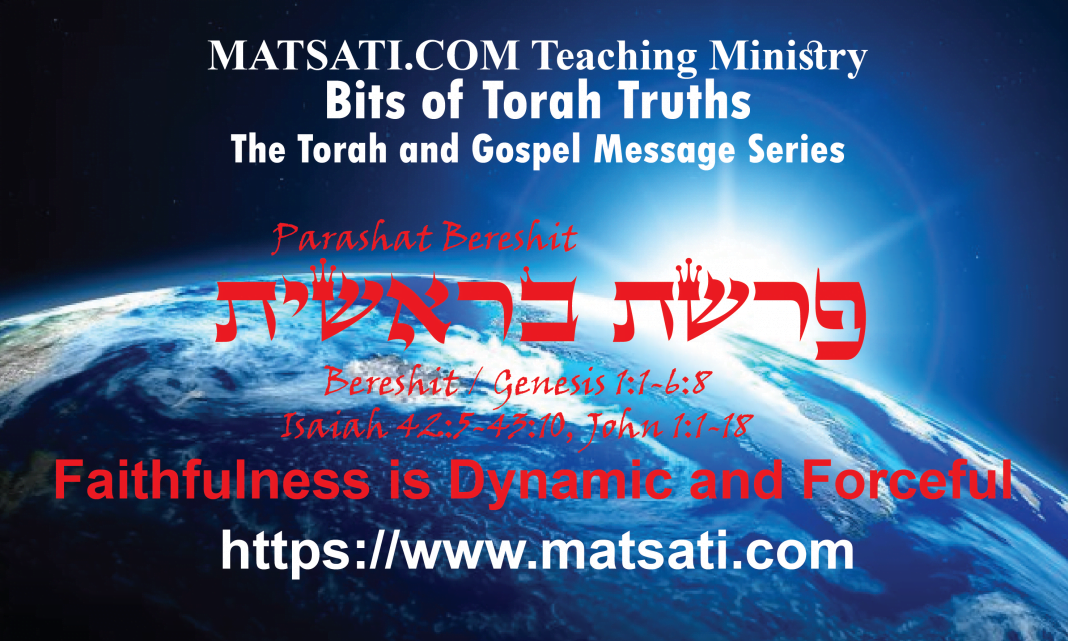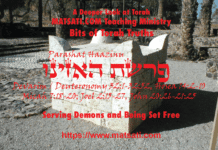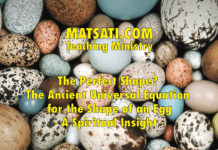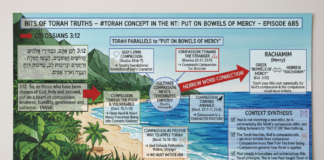The Torah begins with the power of God in creating the world simply by the spoken word, Bereshit / Genesis 1:3 Then God said, ‘Let there be light’; and there was light. (NASB, ג וַיֹּאמֶר אֱלֹהִים יְהִי-אוֹר וַיְהִי-אוֹר:) The first of God’s creation was not the sun, moon, and stars. The first of His creation, according to the Torah, was light. The rabbis teach this was the light of His Righteousness, where the light represents the righteousness of God. This is consistent with what John is saying in His epistle in 1 John 1:5-10.
1 John 1:5-10
1:5 This is the message we have heard from Him and announce to you, that God is Light, and in Him there is no darkness at all. 1:6 If we say that we have fellowship with Him and yet walk in the darkness, we lie and do not practice the truth; 1:7 but if we walk in the Light as He Himself is in the Light, we have fellowship with one another, and the blood of Jesus His Son cleanses us from all sin. 1:8 If we say that we have no sin, we are deceiving ourselves and the truth is not in us. 1:9 If we confess our sins, He is faithful and righteous to forgive us our sins and to cleanse us from all unrighteousness. 1:10 If we say that we have not sinned, we make Him a liar and His word is not in us. (NASB)
The Word of God is closely associated to truth and righteousness. Light and darkness are paralleled to righteousness and unrighteousness. When the Lord said “let there be light” His glory shown forth to give light and life to His creation. It is important to understand, the first of God’s creation, the light, represents His wisdom in righteousness and truth which is a fundamental component of the Gospel Message. This may be why the search for truth is a universal principle. The Lord God created and it was good, and the Lord placed man and woman in the Garden of Eden (Paradise) to tend the garden and take care of God’s creation. The only command He had given Adam and Eve was not to eat from the tree of the knowledge of good and evil. The events that take place after this are recorded in Bereshit / Genesis 3.
Bereshit / Genesis 3:1-7
3:1 Now the serpent was more crafty than any beast of the field which the Lord God had made. And he said to the woman, ‘Indeed, has God said, ‘You shall not eat from any tree of the garden’?’ 3:2 The woman said to the serpent, ‘From the fruit of the trees of the garden we may eat; 3:3 but from the fruit of the tree which is in the middle of the garden, God has said, ‘You shall not eat from it or touch it, or you will die.’‘ 3:4 The serpent said to the woman, ‘You surely will not die! 3:5 ‘For God knows that in the day you eat from it your eyes will be opened, and you will be like God, knowing good and evil.’ 3:6 When the woman saw that the tree was good for food, and that it was a delight to the eyes, and that the tree was desirable to make one wise, she took from its fruit and ate; and she gave also to her husband with her, and he ate. 3:7 Then the eyes of both of them were opened, and they knew that they were naked; and they sewed fig leaves together and made themselves loin coverings. (NASB)א וְהַנָּחָשׁ הָיָה עָרוּם מִכֹּל חַיַּת הַשָּׂדֶה אֲשֶׁר עָשָֹה יְהֹוָה אֱלֹהִים וַיֹּאמֶר אֶל-הָאִשָּׁה אַף כִּי-אָמַר אֱלֹהִים לֹא תֹאכְלוּ מִכֹּל עֵץ הַגָּן: ב וַתֹּאמֶר הָאִשָּׁה אֶל-הַנָּחָשׁ מִפְּרִי עֵץ-הַגָּן נֹאכֵל: ג וּמִפְּרִי הָעֵץ אֲשֶׁר בְּתוֹךְ-הַגָּן אָמַר אֱלֹהִים לֹא תֹאכְלוּ מִמֶּנּוּ וְלֹא תִגְּעוּ בּוֹ פֶּן תְּמֻתוּן: ד וַיֹּאמֶר הַנָּחָשׁ אֶל-הָאִשָּׁה לֹא-מוֹת תְּמֻתוּן: ה כִּי יֹדֵעַ אֱלֹהִים כִּי בְּיוֹם אֲכָלְכֶם מִמֶּנּוּ וְנִפְקְחוּ עֵינֵיכֶם וִהְיִיתֶם כֵּאלֹהִים יֹדְעֵי טוֹב וָרָע: ו וַתֵּרֶא הָאִשָּׁה כִּי טוֹב הָעֵץ לְמַאֲכָל וְכִי תַאֲוָה-הוּא לָעֵינַיִם וְנֶחְמָד הָעֵץ לְהַשְֹכִּיל וַתִּקַּח מִפִּרְיוֹ וַתֹּאכַל וַתִּתֵּן גַּם-לְאִישָׁהּ עִמָּהּ וַיֹּאכַל: ז וַתִּפָּקַחְנָה עֵינֵי שְׁנֵיהֶם וַיֵּדְעוּ כִּי עֵירֻמִּם הֵם וַיִּתְפְּרוּ עֲלֵה תְאֵנָה וַיַּעֲשֹוּ לָהֶם חֲגֹרֹת:
Notice something here in Bereshit / Genesis 3:6 the text states, 3:6 When the woman saw that the tree was good for food, and that it was a delight to the eyes, and that the tree was desirable to make one wise, she took from its fruit and ate; and she gave also to her husband with her, and he ate. (NASB, ו וַתֵּרֶא הָאִשָּׁה כִּי טוֹב הָעֵץ לְמַאֲכָל וְכִי תַאֲוָה-הוּא לָעֵינַיִם וְנֶחְמָד הָעֵץ לְהַשְֹכִּיל וַתִּקַּח מִפִּרְיוֹ וַתֹּאכַל וַתִּתֵּן גַּם-לְאִישָׁהּ עִמָּהּ וַיֹּאכַל:) Eve saw the fruit and the Hebrew text states that the fruit looked good to eat (וַתֵּרֶא הָאִשָּׁה כִּי טוֹב הָעֵץ לְמַאֲכָל) and desirable for learning (וְנֶחְמָד הָעֵץ לְהַשְֹכִּיל). It is interesting how she simply looks at the fruit and considers it good to eat and good for learning. The difficulty with this statement is that one can taste that something is good, but one cannot know by looking at it that something tastes good. This is a very dangerous concept here, looking at something and considering it safe and wondering how it will make you feel? A parallel may be found for example, when one is initially presented with drugs, one asks himself “I wonder how this will make me feel?” “will it make me feel good?” and “no harm will come to me,” etc. Curiosity is a God given thing, but what we do with that curiosity, for sin or for righteousness is up to us. Here, Eve chose to learn what it meant to disobey God’s command. The command was for her good, and was not based upon the Lord simply trying to keep something from her.
The rabbis have the following to say concerning these Scripture verses.
Tur HaAroch, Genesis 3:6 Part 2
וכי תאוה לעינים, “and that its appearance caused one to desire it.” We learn that man’s desires are activated by his eyes, by what he sees.Or HaChaim on Genesis 3:6 Part 1
ותרא האשה כי טוב העץ. Eve saw that the tree was good. The first problem is how could one judge what is good to eat by merely looking at it? Another question is why the Torah describes a feeling of the mouth before describing the effect on the eye? The verse should have read: “she saw that the tree was a beautiful sight and that it was good as food,” in that order. Furthermore, whence did Eve know that the tree was apt to add to her perceptive powers, i.e. לְהַשְֹכִּיל? If the Torah merely intended to tell us that the serpents’s description of the tree had been accurate, why describe the woman as seeing something that she did not see? Also why did the Torah add two superfluous words הוּא, and הָעֵץ a second time? If the repetition of the word is justified, why did the Torah not also write the word הָעֵץ after the word תַאֲוָה?
The rabbis point out how a man’s desire is activated by what his eyes see (what he looks at). In this case, Eve desired what was forbidden. Or HaChaim points out how the feeling of the mouth occurs prior to the effect on the eye. This may be describing how hunger (our appetite) is paralleled to giving into the desires of the flesh. This is a significant observation because what we eat becomes a part of us, of who we are at a cellular level. Our appetite can effect our health and the way we walk. Yeshua spoke of what we eat as bringing eternal life (see John 6) drawing a parallel to eating and drinking of his body and blood, respectively. Note also how fasting is performed in order to starve the body (to beat down the body/desires-of-the-flesh), so we may walk in a more spiritual manner (according to the spirit) and draw nearer to the Lord God in prayer seeking His will and not our own. This is connected to the gospel message in the sense of repentance, humbling ourselves, beating back the body, walking in the Spirit, the indwelling of God’s Spirit (His leading us in our lives), the obedience to His Torah, and being a part of His kingdom. The Torah describes the things we are to turn back towards (repentance) to God’s holy and righteous ways. The Masoretic Text describes the events that follow their having sinned, the consequences of their actions, (the Snake, Adam, and Eve) and then the Lord providing for Adam and even skins suggesting that He had made the first offering for atonement for their sins. The basic tenants of the Gospel Message, to repent, to turn towards God’s Ways, and to seek His forgiveness, all come out of the opening Torah portion. All of these concepts are important and provide us with reasons for opening God’s Torah, reading His Word, and believing in our Father in heaven and His Messiah Yeshua.
The Torah goes on to describe Adam knowing his wife. We read that they had a son, his name was Cain. He knew her again and they had another son, his name was Abel according to Bereshit / Genesis 4.
Bereshit / Genesis 4:1-8
4:1 Now the man had relations with his wife Eve, and she conceived and gave birth to Cain, and she said, ‘I have gotten a manchild with the help of the Lord.’ 4:2 Again, she gave birth to his brother Abel. And Abel was a keeper of flocks, but Cain was a tiller of the ground. 4:3 So it came about in the course of time that Cain brought an offering to the Lord of the fruit of the ground. 4:4 Abel, on his part also brought of the firstlings of his flock and of their fat portions. And the Lord had regard for Abel and for his offering; 4:5 but for Cain and for his offering He had no regard. So Cain became very angry and his countenance fell. 4:6 Then the Lord said to Cain, ‘Why are you angry? And why has your countenance fallen? 4:7 ‘If you do well, will not your countenance be lifted up? And if you do not do well, sin is crouching at the door; and its desire is for you, but you must master it.’ 4:8 Cain told Abel his brother. And it came about when they were in the field, that Cain rose up against Abel his brother and killed him. (NASB)א וְהָאָדָם יָדַע אֶת-חַוָּה אִשְׁתּוֹ וַתַּהַר וַתֵּלֶד אֶת-קַיִן וַתֹּאמֶר קָנִיתִי אִישׁ אֶת-יְהוָֹה: ב וַתֹּסֶף לָלֶדֶת אֶת-אָחִיו אֶת-הָבֶל וַיְהִי-הֶבֶל רֹעֵה צֹאן וְקַיִן הָיָה עֹבֵד אֲדָמָה: ג וַיְהִי מִקֵּץ יָמִים וַיָּבֵא קַיִן מִפְּרִי הָאֲדָמָה מִנְחָה לַיהוָֹה: ד וְהֶבֶל הֵבִיא גַם-הוּא מִבְּכֹרוֹת צֹאנוֹ וּמֵחֶלְבֵהֶן וַיִּשַׁע יְהֹוָה אֶל-הֶבֶל וְאֶל-מִנְחָתוֹ: ה וְאֶל-קַיִן וְאֶל-מִנְחָתוֹ לֹא שָׁעָה וַיִּחַר לְקַיִן מְאֹד וַיִּפְּלוּ פָּנָיו: ו וַיֹּאמֶר יְהוָֹה אֶל-קָיִן לָמָּה חָרָה לָךְ וְלָמָּה נָפְלוּ פָנֶיךָ: ז הֲלוֹא אִם-תֵּיטִיב שְֹאֵת וְאִם לֹא תֵיטִיב לַפֶּתַח חַטָּאת רֹבֵץ וְאֵלֶיךָ תְּשׁוּקָתוֹ וְאַתָּה תִּמְשָׁל-בּוֹ: ח וַיֹּאמֶר קַיִן אֶל-הֶבֶל אָחִיו וַיְהִי בִּהְיוֹתָם בַּשָּׂדֶה וַיָּקָם קַיִן אֶל-הֶבֶל אָחִיו וַיַּהַרְגֵהוּ:
According to the Hebrew Scriptures in Bereshit / Genesis 4:2 the text literally states, (וְקַיִן הָיָה עֹבֵד אֲדָמָה) Cain was a עֹבֵד (servant, worshiper, slave) of the adamah (earth, ground, אֲדָמָה). Abel on the other hand was a shepherd of the sheep (וַיְהִי-הֶבֶל רֹעֵה צֹאן). The parallels we find here, Cain being a servant of the world, he served the ways of the world, as opposed to the ways of God. The word Adamah as opposed to Eretz may parallel the nations and Israel, respectively, Cain chose the world, and not the Land of Israel (HaEretz) symbolizing God’s ways for His people. On the other hand, Abel was a shepherd who guided, nurtured, cared for others having a mind for God and His ways.
Following Adam and Even eating of the fruit from the Tree of the Knowledge of Good and Evil, the earth was cursed (corrupted) as a part of Adam’s punishment to lifelong agricultural toil. This explains why the Lord God favored Abel’s offering of sheep (צֹאן) to Cain’s offering of fruits and vegetables. Note also how Cain killed his brother, the Adamah was complicit in Cain’s murder of his brother in that the ground swallowed Abels innocent blood as if to conceal the crime. The Lord God punished Cain by making the ground barren to him, and estranging him from the Adamah (the earth). The rabbis draw in an additional commentary on the word adamah (אֲדָמָה) speaking of the Hebrew word dam (דם) meaning “blood” and drawing a parallel to the purpose for the Kashrut on the prohibition of consuming blood. The blood of the animal must return to the ground and be covered over with earth.
The rabbis go on to say the following on Bereshit / Genesis 4:
Rabbeinu Bahya, Bereshit 4:2 Part 1
וקין היה “and Kayin had become, etc.” We would really have expected the Torah to write ויהי קין עובד אדמה, similar to the Torah’s describing Hevel’s vocation as ויהי הבל רעה צאן, “Hevel became a shepherd of sheep.” The reason the Torah changed its style in describing the respective vocations of the two brothers was that there was a cardinal difference between the vocation of the one and the vocation of the other. Hevel was a righteous person whereas his brother Kayin was a wicked person. The whole episode teaches that good and evil have the same root. The root by itself is totally good; after all when Adam was created he was totally good. Nonetheless we observe that from such a good “root,” two sons with totally different personalities emerged. Seeing that both wicked people and good people developed out of the same root is proof that there was only One Creator, that evil and good are not separate domains, that there are no two competing deities in this world, one promoting the source of all that is good and promoting it, and one which is the root of all that is bad and promoting same. In fact, if you look at Isaiah 45,7 עושה שלום ובורא רע, אני ה’ עושה כל אלה, “Maker of peace, Creator of evil, I the Lord am doing all this,” G’d realised that unless He, personally, took responsibility for being the originator of anything good and evil, people would believe that there must be two totally separate domains, two totally diverse prime causes. An additional reason why the Torah had to write וקין היה עבד אדמה is because the potential of a personality such as Kayin had preceded his birth; he had not invented it. [Rabbi Chavell quotes an interesting numerical value of the combined words עבד היה is the same (96) as that of the planet מאדים, Mars, which stands for bloodshed, for war. This would be an additional reason for the Torah having written קין היה, instead of ויהי קין וגו’..]
The rabbis pick up on the differences between the way the Hebrew text is written, and suggest an explanation as there being a significant difference between the two brothers indicated by their choice of vocation (work, job). Abel was righteous, and Cain was wicked (Note also the parallels we find later on between Jacob and Esau). The prophet Isaiah defines the difference between wickedness and unrighteousness.
Isaiah 55:6-9
55:6 Seek the Lord while He may be found; Call upon Him while He is near. 55:7 Let the wicked forsake his way And the unrighteous man his thoughts; And let him return to the Lord, And He will have compassion on him, And to our God, For He will abundantly pardon. 55:8 ‘For My thoughts are not your thoughts, Nor are your ways My ways,’ declares the Lord. 55:9 ‘For as the heavens are higher than the earth, So are My ways higher than your ways And My thoughts than your thoughts. (NASB)
According to Isaiah, wickedness is related to what we do, and unrighteousness to what we think. The Lord God is not just concerned with what we do, but also in how we think. This comes down to having faith, and being faithful. The rabbis say that both good and evil have the same root, where the root is good, but in the case of two sons, one was good and one was evil. The rabbinic concept here is that “Seeing that both wicked people and good people developed out of the same root is proof that there was only One Creator, that evil and good are not separate domains, that there are no two competing deities in this world, one promoting the source of all that is good and promoting it, and one which is the root of all that is bad and promoting same.” The difference the rabbis are emphasizing is the way in which the text is written in Bereshit / Genesis 4:2, the description of Cain (וְקַיִן הָיָה עֹבֵד אֲדָמָה) and the description of Abel (וַיְהִי-הֶבֶל רֹעֵה צֹאן) and the reason for the Torah having written קין הָיָה, instead of ויהי קין וגו where הָיָה is written in the past tense (Cain was) and וַיְהִי the third-person masculine singular vav-consecutive imperfect. An Imperfect verb is used generally to indicate an action that is not complete, or an action that either occurs in the present or will occur in the future. The way the text is written, Cain “was” a servant of the land, this “was” a completed action. Abel on the other hand had not been completed in his work as a shepherd since being a leader and a teacher never ends, but is an ongoing process of learning and growing. In Cain’s case, the Lord God told him that sin was crouching at his door wanting to have him. (Bereshit / Genesis 4:6 Then the Lord said to Cain, ‘Why are you angry? And why has your countenance fallen? 4:7 ‘If you do well, will not your countenance be lifted up? And if you do not do well, sin is crouching at the door; and its desire is for you, but you must master it.’ NASB, ו וַיֹּאמֶר יְהוָֹה אֶל-קָיִן לָמָּה חָרָה לָךְ וְלָמָּה נָפְלוּ פָנֶיךָ: ז הֲלוֹא אִם-תֵּיטִיב שְֹאֵת וְאִם לֹא תֵיטִיב לַפֶּתַח חַטָּאת רֹבֵץ וְאֵלֶיךָ תְּשׁוּקָתוֹ וְאַתָּה תִּמְשָׁל-בּוֹ:) Cain did not turn from his ways, and his sinful thoughts brought him to killing His brother. What we are being taught here in Parashat Bereshit is of faith and faithfulness. Adam and Eve chose to disobey God’s command. Cain chose to be bring God a sacrifice from his own means, by his own ways as opposed to the way God wanted. Abel however lived by faith, and he died because he did what was right. The Torah explains to us how even in a perfect state, we are given to make the wrong choices and sin against God. We need God’s help to live a righteous and holy life.
Paul in his epistles teaches us that faith enables a person to attain the righteousness of God and that there is no tension between faith and the Torah. The term faith is better understood as “faithfulness” because the concept includes much more than the English words belief and trust. Righteousness involves the redemptive work of God in His salvation process and in the renewed lives of those who are faithful.
The idea of faithfulness is much more dynamic and forceful than the motionless idea that one is declared righteous at a fixed point in time.
Righteousness is rooted in the Torah, and has movement, form, and meaning. It is active and powerful to bring about the transformation of conduct. If we have a second look at what Paul wrote to us in Romans and Galatians, we can see how he speaks of faith, righteousness, and the Torah going hand-in-hand together being coupled to faithfulness. He writes with such enthusiasm that he says in Romans 3:31 Do we then nullify the Law through faith? May it never be! On the contrary, we establish the Law. (NASB) Following this statement Paul goes into a deep discussion about the righteousness of Abraham which was based upon faith (see Romans 4). Paul’s interpretation of Bereshit / Genesis 15:6 states “Abraham believed God and was accounted to him as righteousness” is in the form of a Jewish midrash. Paul uses midrash to draw out the deeper meaning of righteousness with Abraham as the example given to us from the Scriptures. Paul urges his listeners to respond in faith like that of Abraham, who pioneered the way to righteousness. The prophet Habakkuk says “but the righteous will live by his faith” (Habakkuk 2:4). He is saying, we will live by our faith, meaning we are putting our faith into action. Living a life of righteousness is a dynamic experience. It is the power of God to live righteous lives in obedience to His word. This is true redemption and salvation because it embraces the new life of walking in the way of the Torah, following God’s ways, walking in the footsteps of the Messiah, following Jesus! As a path to salvation, the way of righteousness is experienced as a present reality that culminates in the coming of God’s Messiah. This is understood in the future expectation of God sending His Messiah, and of the future expectation of the Messiah Yeshua returning. By faith we live illustrates for us a supernatural strength that enables each one of us to participate in the redemptive movement of God, in His Kingdom (Galatians 5:21). According to Paul, the power of God is released for us in our lives by faith in the Messiah Yeshua. In the Torah portion, Adam, Eve, and Cain did not seek God’s counsel for help to overcome. Today, using them as an example from the Torah, we are to seek the Lord God our Father in heaven for help in the name of His Messiah Yeshua. And it is in this way that it is possible to experience God’s redemption in every day life. The Torah speaks of the “life of righteousness” or the “way of righteous living” and according to faith as defined in the Scriptures, our faith is lived out in the way of righteousness as we believe in the Messiah and receive empowerment in our lives from God’s Holy Spirit to overcome sin, to bear God’s testimonies, and to bring glory to His Name!
This is how the Gospel and the Torah are connected.









